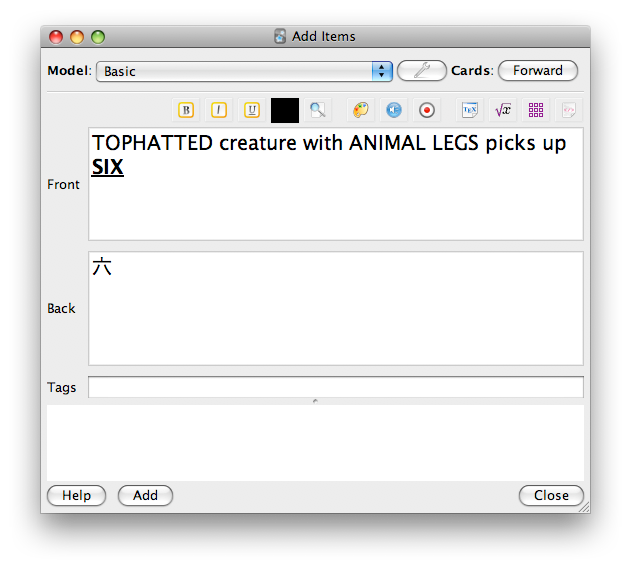Greetings fellow Japanese language enthusiasts!
Cubsey has been thinking a lot about language lately. How it is learned, why it used, why on earth would I want to spend the time to learn it. Everyone has their own reason/motivation for wanting to learn a language, but the most important thing is HOW you learn it. If you (like me) strive to learn Japanese (to whatever extent), then hop on board! We are about to embark on a beautiful journey.
I recently came across a website that forever changed my views on how I wanted to learn Japanese.
All Japanese – All The Time
(Our good friend iindigo from the BxT forums gave hint into this website in his forum post A Fast Way to Learn the Base 2000 Kanji.)Basically, this website was written by a guy named Khatzumoto, who taught himself to become completely fluent in Japanese in only 18 months. I strongly STRONGLY suggest you read through his site if you have even the faintest interest in learning Japanese.
His words of advice will also be serving as a guideline for the BxT lessons as well.
So, where do we start? Well…the answer is: KANJI!!!
Whip out those writing utensils, because we have over 9000 of them to learn!
“But Cubsey, thats impossible.”
Rubbish! Those kinds of thoughts are irrelevant and will only hold you back!
They key to success is
1) Believing in yourself and that you CAN do it.
2) HOW they are learned.
So, without further ado, I present to you The Helsig Method.
First off, it would be wise to check out iindigos post on this. The relevant topic
Without getting into too much detail, this method basically assigns a story to each Kanji with clues of what the kanji looks like.
What will you need to accomplish this?
1) You will need to download a software program called Anki (its free).
Where to get Anki
Essentially, Anki is a software flashcard system, but what makes it unique is that YOU judge how well you did with each card, and the program will choose the appropriate time to review said card. This is referred to as a Spaced Repetition System (SRS).
2) You will need This text file: The required text file
3) You will need a notepad and a writing utensil of your choice.
4) You will need to devote time DAILY to studying, if you hope to get anywhere.
How much time? Thats completely up to how fast and how much you want to learn.
Once you have downloaded and installed Anki, its time to setup your study deck.(Go ahead and open up that rtf file from earlier.)When you first open up Anki, you will see an Add Material button. Go ahead and click on that to begin building your deck. Im going to quote iindigo on how this is done.
“Creating new cards in Anki is easy. As seen below, just write your mnemonic story in the Front portion of the card and its corresponding kanji on the back. Whatever you do, DO NOT put the kanji on the front of the card. Underline and bold the kanjis keyword (definition) for emphasis.”

“Once you are finished with the card, click Add and start on the next card. Continue until you have hit whatever number of Kanji that you want to study for that day.”
Be sure to save your deck. 😉
Once you’re done inputting your cards you will notice anki has changed to a screen with study options. This is where you select how many new cards you want to learn per day. How many should you do? That’s completely up to you! I personally do 30 new cards a day. iindigo does 50!
That may be a bit much for a casual Japanese learner, so 5 new kanji a day should suffice quite nicely.
When you are ready, click on Start Reviewing.
Pull out that notepad and writing instrument, and based on the story, try to write/draw what you think the kanji looks like. When you have written it down, click the Show Answer button.
So, how did you do? This is the part where you have to judge yourself. I usually click Again if I completely screwed up the kanji, Hard if it looks sloppy or was difficult to remember, Good if it was…well..GOOD, and Easy if I COMPLETELY knew what the kanji looked like and would remember its meaning if I saw it on the street. Remember, Anki will keep track on progress FOR you (assuming you are honest with yourself). Anki will automatically add new cards to your review everyday (assuming you inputted them).
Good luck my friends. This really is a brilliant method of learning. I walked into my local Asian store the other day, and I was ACTUALLY able to decipher product labels.
Its a good feeling to see how you have progressed through your studies.
Remember, this is just the FIRST step.
Theres A LOT more ground to cover!
But, we shall continue our studies during the next blog.
Again, I strongly encourage you to read through the All Japanese All the Time website. Its a mountain of incredible knowledge and advice that simply cant be found anywhere else.
(Ill have to work it out with “da boss” first, but we may offer kanji challenges and prizes later on down the road!)Until next time, keep on studying!
-Cubsey
Ps: I should mention that if youre studying only a few cards a day (lets say..less than 15) you may want to change the Review Schedule in Anki.
With Anki open, go to Settings>Deck Properties and open the Advanced tab.
In there, you can change the Interval of when a card shows up again.
Youll want to make it sooner if you are studying less cards.
Play around with the setting a bit until you feel comfortable with it.
